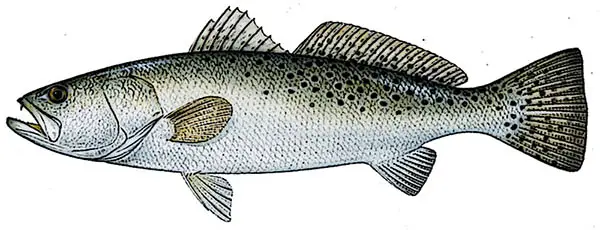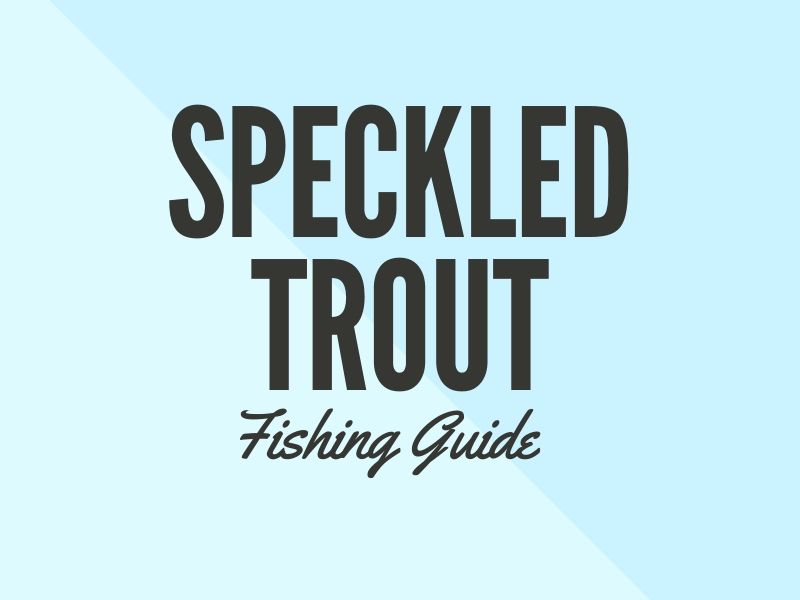Speckled trout also known as spotted seatrout or specks, are a popular game fish found throughout parts of the Southern United States ranging from the Gulf of Mexico and the Atlantic Ocean all the way down from Florida up to Maryland. Though they are called trout, they are actually a member of the drum family of fish.
In this guide, we will cover how to identify speckled trout, where to catch them, their seasonal patterns, the equipment you will need, and give a few additional tips to help you catch more speckled trout.
Speckled Trout Identification
Speckled trout have long bodies with dark spots. They are silver in color often with green-tinted backs. In some waters, they may also take on a golden hue. Their lower jaw is longer than their upper jaw, and they have canine teeth.

On average most speckled trout reach sizes around 11 to 19 inches in length, though larger members of the species can reach up to 26 inches in length. Most speckled trout weigh between 2 to 3 pounds, but the world record speckled trout weighed in at a whopping 17.7 pounds.
Where to Catch Speckled Trout
Speckled trout are commonly fished throughout the Gulf of Mexico and the Atlantic Ocean ranging as far south as Florida up to Maryland.
They are most common in shallow bays and grassy flat areas. You can also catch them in other inshore areas too such as from the surf or in coastal rivers. They are usually in shallow waters when the temperature is warm, and when it’s cold they move into deeper bay waters.
Speckled Trout Seasonal Patterns
Fall
As water temperatures begin to cool trout move from the summer spawning sites back inside marshes where they can be caught much more easily. Look for them in shallow inlets and creeks in the autumn. Areas with structure are also popular. Fish areas with bridges, grass beds, oyster bars, and docks. The hot spot will be places that are between 3 feet and 10 feet of water.
Winter
In wintertime, as the cold fronts come through, speckled trout move out of the bays and swim up into coastal rivers throughout the Gulf of Mexico. You can also find them in marshes. Look for deeper holes in marshes ranging from 8 to 20 feet deep. Ideally, you will want to fish near a shallow flat with deeper holes nearby. If the water is warm the speckled trout will be in the shallows, if it’s colder, they will be in the deeper sections. Speckled trout like to stay near areas where they can move between deep and shallow waters easily.
Spring
In the springtime look for specks near grass beds, sandbars, oyster beds, piers, beach fronts, and ocean inlets. Speckled trout are looking for baitfish and shrimp, so the areas with the shallow waters teeming with their food are where you will find the fish. Look for areas with structure between 3 to 10 feet deep. This is the prime spot for specks.
Summer
When the water heats up in the summer to the mid to upper seventies, the spawning season begins. Speckled trout look for waters with moderate salinity in lower bays. They typically spawn in areas with good current flow like channels and passes. Look for shallow grass-sand bottoms around 6 feet deep if you’re fishing a middle coast area.
By mid-summer speckled trout season is at a frenzy. You can catch them near shallow structure where plenty of shrimp and baitfish hang out. As we stated earlier, specks like shallow areas with easy access to deeper water so they can move freely, so be on the lookout for these spots.
Summer is also prime time to fish the surf for speckled trout. When fishing the surf you need to learn to identify the sandbar and troughs between the bars. Depending on the wind and tide flow, one of these troughs in the surf will be teaming with baitfish. This is where you want to place your bait when fishing for specks. Try to learn how the changing winds and tides affect the surf, and where the baitfish are likely to be. This is the key to finding the trout.
Best Time to Catch Speckled Trout
Summer is known as the best time to catch trout. Usually, between May and July, the best speckled trout fishing will occur. Particularly summer mornings specks seem to be incredibly active and easy to catch. You can also have a lot of success fishing nights around 10 to midnight.
Best Equipment for Speckled Trout
Fishing Rods and Reels
The most common gear setup for speckled trout is a spinning rod and reel. They are the easiest to use and are incredibly versatile, making them great for a variety of different conditions. A 7-foot spinning rod with medium action is a good choice. Spotted trout don’t really put up a fight so you can use a spinning reel that has a high gear ratio to reel in the fish quicker.
If you’re an experienced angler, you may prefer using a baitcasting rod and reel. These are more precise and have better power when fishing for larger speckled trout. They do take a little bit more expertise to use though. If you’re going to be using a baitcasting rod, something around 6 to 7 feet with medium action is perfect for specks.
Fly rods are also commonly used for speckled trout. Try to use an 8 weight fast action rod. This will give you a long casting ability since speckled trout are known to be quite mobile.
Lures and Baits
Topwater Plugs
A good topwater surface lure is one of the most effective lures you can use for shallow specks. Not to mention they are the most enjoyable to use because you get to see hungry trout coming to the surface to attack your bait. Try to pick one that closely resembles the forage the speckled trout are used to eating.
Suspending Twitchbait
You can also use a suspending twitchbait that matches forage the trout are used to eating. These are made to slowly sink to mid-level depths of the water. You can slowly twitch them to mimic baitfish and get the trout biting. They are typically best in cooler weather when the fish aren’t as active.
Spoons
We’re huge fans of spoon lures. They are good for fishing oyster bars and seagrass beds. Just make sure you are using one with a weedless design. The wobble of a spoon can be irresistible to hungry seatrout.
Berkley Gulp
Berkley gulp is a favorite of many anglers fishing for seatrout. If you’re in an area with a lot of shrimp, try Berkley Gulp Shrimp, and you might find it very productive.
Shrimp
Live shrimp is often the best choice for speckled trout. If you’re fishing an area where they regularly feed on shrimp, it’s probably your best option. Just the smell of shrimp can drive the fish into a feeding frenzy.
Mullet
Smaller baits work better for smaller trout, but if you’re after giant speckled trout, you need to be using baitfish like mullet. Try to use a mullet around 5 to 6 inches on a #1 or #2 size hook.
Fishing Line
For speckled trout, most anglers will opt for monofilament line or braided line. When using monofilament, something around a 12-15 pound test line should work well. For braided, use around 20-pound line. Braid is good for casting longer distances, and it has good sensitivity so you can quickly set your hook.
Hooks
For speckled trout use either a size #2, #1, or 1/0 hook. Most anglers prefer to use circle hooks or kahle hooks for fishing speckled trout. These will give you a good firm hook set without damaging the trout. They are also pretty easy to remove.
Tips to Catch More Speckled Trout
Fishing the Morning with Topwaters
The mornings are known as the best time to fish for speckled trout. But take it one step further and use a topwater plug to get the hungry trout to the surface. Morning trout are the most likely to attack topwater lures. Typically the first 2 hours after the sun is up is your best time to use these lures.
Fish the Full Moon
Full moons are known to increase fish activity. The tidal movements can make certain sections of the water full of baitfish. The hungry speckled trout are sure to take advantage of this feeding opportunity.
For Bigger Trout Use Bigger Live Bait
If you’re after a larger than average speckled trout you have to ditch the small bait. Smaller lures are great for catching a lot of smaller fish, but big specks won’t bother your lure. 5 to 6-inch live bait like mullet, croaker, or menhaden is your best bet if you’re after a monster.
Related Posts:
Rainbow Trout Fishing Guide
How to Catch Pompano
